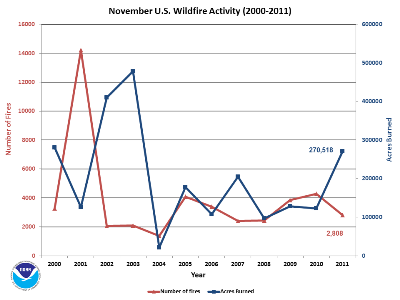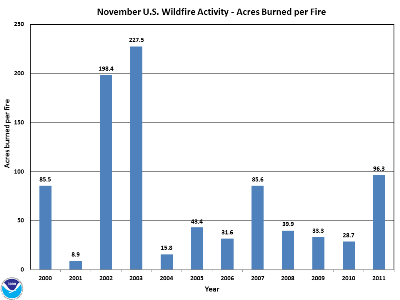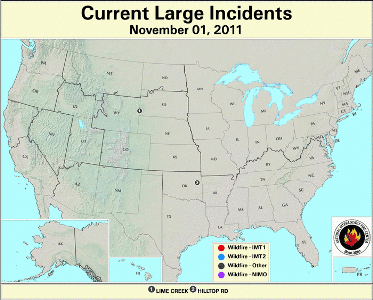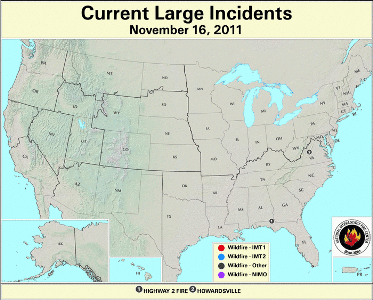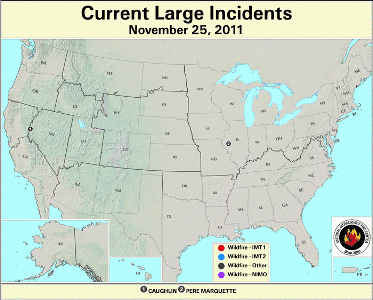Updated: 7 November 2011
Overview
During November 2011, approximately 270,518 acres (109,475 hectares) burned across the country, the third most on record for the month. The record for November acreage burned occurred in 2003, when 478,648 acres (193,700 hectares) were charred. During the January-November period, 8.5 million acres (3.4 million hectares) burned across the U.S. — the 3rd most in the 12-year period of record. The most acres burned during the January-November period occurred in 2006 when 9.51 million acres (3.8 million hectares) burned nationwide.
According to the National Interagency Fire Center (NIFC) :
For more wildfire statistics visit U.S. Wildfires.
Significant Events
One of the worst fires in Nevada history, according to media sources, broke out on November 18th near Reno. The Caughlin fire grew rapidly out of control with winds gusting to 60 miles per hour. The fire’s location near suburban Reno and its fast moving nature prompted the evacuation of 9,500 people. Dozens of homes and other structures were damaged or destroyed. A 74-year-old man died after he suffered a heart attack and lost control of his car while fleeing with his wife. The fire was particularly difficult to fight due to the combination of the high winds, rocky terrain, and accessibility. The fire was contained after burning nearly 2,000 acres.
Discussion
During November wetter than normal conditions were present across parts of the Southern Plains and South, stretching into the Great Lakes. Below normal precipitation was observed across Texas and Forida, New England, the Northern Plains and parts most of the West. Warmer-than-average conditions dominated east of the Rockies with the warmest temperature anomalies occurring across the Ohio Valley and Northeast. Below-normal temperatures were present for much of the West. See the U.S. Temperature and Precipitation discussion for more information. According to the U.S. Drought Monitor, during November, across the Contiguous U.S., the overall size of the drought footprint shrank. Drought conditions remained generally unchanged across the Southeast during the month. Drought conditions improved by one to two categories across Illinois, northern Missouri, and southern Iowa, while drought worsened in northern Iowa. The largest drought improvements were across the Southern Plains, where several storm systems brought beneficial rainfall to the drought-stricken region. Drought conditions improved anywhere from one to three categories across Oklahoma and Texas during the month, depending on where the precipitation fell. However, longer term precipitation deficits still exist across the region, and a large area of the Southern Plains are still experiencing extreme-to-exceptional drought. Drought conditions remained generally unchanged across the Southwest.
Wildfire information and environmental conditions are provided by the National Interagency Fire Center (NIFC) and the U.S. Forest Service (USFS) Wildland Fire Assessment System (WFAS).
At the beginning of November, there were two large wildfires active across the United States. One large wildfire was burning in western South Dakota, where dry conditions dominated during the last half of October. This created very dry small fuels (low 10-hour fuel moistures) and high fire danger
fuel moistures) and high fire danger across the region. The fire was mostly fueled by tall grasses and brush. A second large wildfire was burning across eastern Oklahoma. Long term dryness across the Southern Plains caused larger fuels (100-hour
across the region. The fire was mostly fueled by tall grasses and brush. A second large wildfire was burning across eastern Oklahoma. Long term dryness across the Southern Plains caused larger fuels (100-hour and 1,000-hour
and 1,000-hour fuel moistures) to be very dry. Observed Keetch-Byram Drought Index (KBDI)
fuel moistures) to be very dry. Observed Keetch-Byram Drought Index (KBDI) values and fire danger
values and fire danger were high across the region.
were high across the region.
By the middle of November, two large wildfires were burning across the country — one in Virginia and one in the Florida panhandle. The fire in western Virginia was accompanied by low 100-hour fuel moistures, but all other measured variables were not conducive for wildfire development. Across the Florida panhandle, extremely high KBDI
fuel moistures, but all other measured variables were not conducive for wildfire development. Across the Florida panhandle, extremely high KBDI values and low 10-hour
values and low 10-hour fuel moistures were reported.
fuel moistures were reported.
At the end of November, two large wildfires were active in the United States. One large fire was burning in Illinois, where dryness in the short term caused low 10-hour fuel moistures. The second large wildfire was the Caughlin Fire near Reno, Nevada. Along the western extent of the Great Basin, low 10-hour
fuel moistures. The second large wildfire was the Caughlin Fire near Reno, Nevada. Along the western extent of the Great Basin, low 10-hour fuel moistures and high KBDI
fuel moistures and high KBDI values were reported at the end of November.
values were reported at the end of November.
 NOAA's National Centers for Environmental Information
NOAA's National Centers for Environmental Information
